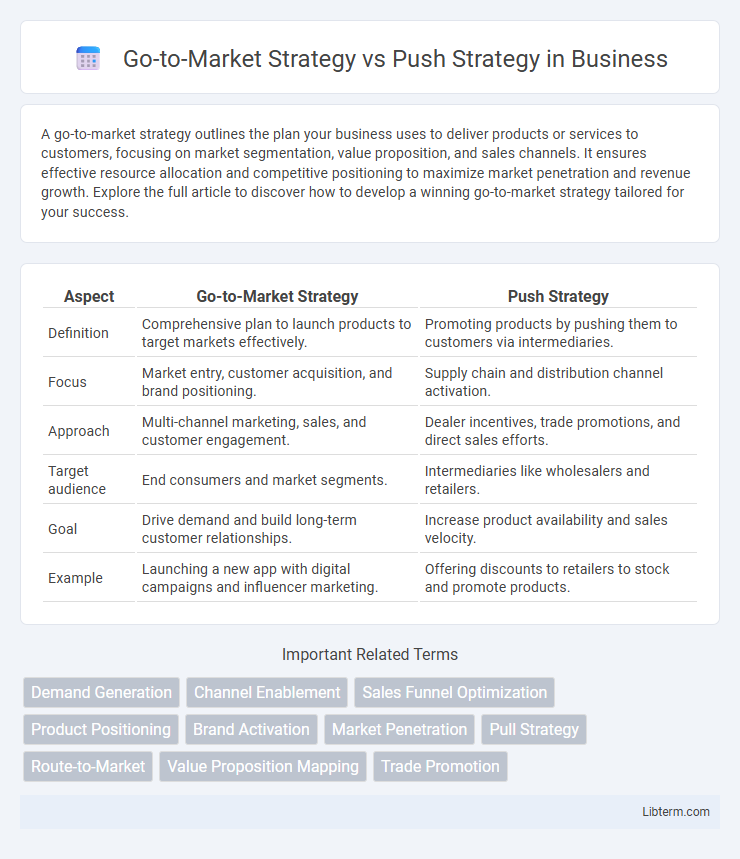A go-to-market strategy outlines the plan your business uses to deliver products or services to customers, focusing on market segmentation, value proposition, and sales channels. It ensures effective resource allocation and competitive positioning to maximize market penetration and revenue growth. Explore the full article to discover how to develop a winning go-to-market strategy tailored for your success.
Table of Comparison
| Aspect | Go-to-Market Strategy | Push Strategy |
|---|---|---|
| Definition | Comprehensive plan to launch products to target markets effectively. | Promoting products by pushing them to customers via intermediaries. |
| Focus | Market entry, customer acquisition, and brand positioning. | Supply chain and distribution channel activation. |
| Approach | Multi-channel marketing, sales, and customer engagement. | Dealer incentives, trade promotions, and direct sales efforts. |
| Target audience | End consumers and market segments. | Intermediaries like wholesalers and retailers. |
| Goal | Drive demand and build long-term customer relationships. | Increase product availability and sales velocity. |
| Example | Launching a new app with digital campaigns and influencer marketing. | Offering discounts to retailers to stock and promote products. |
Understanding Go-to-Market Strategy
A Go-to-Market Strategy defines the comprehensive plan for delivering a product or service to the target market, focusing on customer segmentation, value proposition, and competitive positioning. It integrates marketing, sales, distribution, and pricing tactics to ensure market entry success and sustainable growth. Understanding this strategy helps businesses align resources efficiently, maximize market reach, and optimize product adoption compared to the narrower scope of a Push Strategy, which emphasizes direct promotion and sales efforts.
What Is a Push Strategy?
A push strategy involves actively promoting products by pushing them through distribution channels to reach customers, often using tactics like trade shows, direct selling, and point-of-sale displays. This approach prioritizes building relationships with wholesalers, retailers, or distributors to encourage them to stock and sell the product. The goal of a push strategy is to generate demand at the distribution level, accelerating product visibility and sales momentum.
Key Differences Between GTM and Push Strategies
Go-to-Market (GTM) Strategy encompasses a comprehensive plan for delivering a product to target customers through various channels, focusing on market segmentation, value proposition, and customer engagement. Push Strategy relies primarily on proactive promotion and distribution efforts aimed at intermediaries like retailers to "push" the product towards consumers, emphasizing sales force and trade promotions. The key differences lie in GTM's broader approach integrating product positioning and customer insights, while Push Strategy centers on aggressive supply chain and sales tactics to drive immediate product availability and demand.
Core Components of a Go-to-Market Strategy
Core components of a Go-to-Market strategy include target market segmentation, value proposition, distribution channels, and customer acquisition tactics. This strategic framework aligns product positioning with customer needs, while optimizing sales and marketing efforts to maximize market penetration. Unlike a Push Strategy, which emphasizes aggressive promotion and direct sales efforts, a Go-to-Market strategy holistically integrates market research, competitive analysis, and operational planning to successfully launch and sustain a product.
When to Use a Push Strategy in Business
A push strategy is most effective when launching new products in markets with low brand awareness or when targeting intermediaries like wholesalers and retailers to promote the product downstream. Businesses use push strategies in industries with short sales cycles or when demand is not yet established, requiring active promotion through trade shows, direct selling, and incentivizing distributors. This approach accelerates product placement and shelf space, making it crucial for companies seeking rapid market penetration or when competing in highly saturated markets.
Advantages of Go-to-Market Strategy
Go-to-Market (GTM) Strategy offers targeted market entry by aligning product development, sales, and marketing efforts, ensuring a cohesive approach to capturing customer segments. This strategy enables faster customer acquisition and better resource allocation by focusing on specific buyer personas and tailored value propositions. Companies benefit from improved market understanding and adaptability, which enhances competitive positioning and long-term growth potential.
Limitations of Push Strategy Tactics
Push strategy tactics often face limitations such as high costs related to aggressive promotions and trade discounts, which can reduce profit margins. These tactics may also lead to inventory accumulation, causing supply chain inefficiencies and potential product obsolescence. Furthermore, push strategies frequently lack long-term customer engagement, resulting in lower brand loyalty compared to pull or go-to-market strategies that emphasize demand creation and market positioning.
Integrating Go-to-Market and Push Approaches
Integrating Go-to-Market (GTM) and Push Strategies enhances market penetration by aligning product launches with targeted promotional efforts, leveraging direct sales channels to drive customer acquisition. This approach utilizes comprehensive market analysis and targeted messaging to ensure timely delivery of value propositions while actively promoting products through intermediaries. Combining GTM's strategic planning with Push Strategy's proactive sales tactics optimizes resource allocation, accelerates revenue growth, and strengthens competitive positioning.
Real-World Examples: GTM vs Push Strategy
A Go-to-Market (GTM) strategy focuses on targeting specific customer segments with tailored marketing and sales approaches to maximize product adoption, exemplified by Apple's launch of the iPhone, where direct engagement and ecosystem integration were key. In contrast, a Push Strategy emphasizes aggressively promoting products through distribution channels, as seen in Procter & Gamble's widespread retail promotions and incentives to push products onto store shelves. Companies often blend GTM precision with Push Strategy reach to optimize market penetration and customer acquisition.
Selecting the Right Strategy for Your Business
Choosing between a Go-to-Market Strategy and a Push Strategy depends on your business goals, target audience, and product lifecycle stage. A Go-to-Market Strategy offers a comprehensive plan for market entry and customer acquisition, while a Push Strategy emphasizes direct promotion to drive immediate sales. Evaluate market demand, customer readiness, and sales channel effectiveness to select the strategy that aligns with your brand positioning and revenue objectives.
Go-to-Market Strategy Infographic

 libterm.com
libterm.com